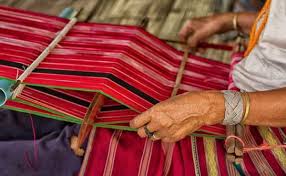Introduction:
The third handloom census (2010) clearly indicates that the handloom industry of India is not in a very healthy state. The key indicators are alarmingly challenging for sustainability of the handloom sector. Inevitability of the challenges with the changing life styles is a big question mark! Revival back to its originality is in the critical stage, with the changing value system and perception in the modern society. With the obvious change of mind set from traditional to modernity is becoming so evident that the handloom is likely to become a museum piece of craft of the history in the near future. Decline rate of 7% per year in number of weavers, during the past years is a clear indication of the sun-setting trend of the handloom sector.
In the positive side, the third census shows a rise in the number of handloom households, from 25 lakhs in the second census to 27.8 lakhs; an increase of about 11%. Of the total handloom households, 87 % are rural and 13 % are urban. However, in totality there is a gap and this gap will create more demand and attract more selective and passionate weavers to enjoy the genuine fruit of the looms. This situation will bring the change by itself to the handloom sector to get revolutionized.
This article aims to introspect some critical aspects of handloom sector from the point of its sustainability in relation to the current status and 5 M’s (Men, Machine, Material, Market and Money)
Manpower perspective:
- Current profile of the weavers:
- India’s weaving fraternity is of over four million weavers including its allied production workers. It is the second largest employer next to the agricultural sector.
- Out of 89% of the adult weavers, 49% are of the age group of 18 to 35 years, 21% are of 36 to 45 years, 15% are of 46 to 60 years and 4% are of 60 years and above. This phenomenon is likely to be a big challenge unless the handloom sector attracts more young generation in to this trade.
- Out of all adult weavers male and female weavers are 22% and 78% respectively.
As regards the educational level of the weavers are concerned there are 83% weavers who are under HSLC level and only 17% are HSLC and above. In a study done on women handloom weavers of Assam, it was found that, only 13% of the weavers had higher education and 87% were under HSLC level (Barooah and Dedhia:2012). This clearly indicates that literacy level of weavers is going to decrease drastically.
- By nature of employment, there are 61% independent weavers, 34% under master weavers / private owners and only 5% under institutional employment.
- Average earning of the weavers is Rs. 3400 per month as against all India average of Rs. 4500 per month and far below the wages as per minimum wage act for an un-skilled worker.
- The quality of life of a handloom weaver is far below, compared to an un-skilled, semi-skilled or skilled worker of an Institution.
Machinery perspective:
- There is not much technology induction in the handloom sector, due to the limited research and inherent scope. The traditional techniques are still most popular, resulting in the existing constraints remained un-resolved. This applies to pre-loom, on loom as well as the post-loom stage.
- As a result, hand weaving remains labour-intensive, low productive etc. as ever.
Material perspective:
- Raw material used in the handloom sector varies subject to quality, product, availability, place, region, market demand, price, tradition, proximity to yarn market etc. Most expensive as well as the cheapest yarns are being used including critical hand spun as well as mill-spun yarns and at times yarns are used irrespective of being compatible or feasible.
- Many a times it is found that the material used in the handloom do not have a sustainability consideration.
Market perspective:
- Handloom enjoys a special market segment for the inherent beauty in its products. Sheer love for hand-woven products, the philosophy, the economic arguments, the social impact, tradition, sentiments, exclusivity, minimum order quantity etc. are some of the attractive elements that will make handloom sustainable, without much doubt.
- Direct market linkage with the developed communication media will boost the market potential further.
- The biggest threats in the market place are the power loom products and the cheap imports, which are inevitable in the open market policy across the world.
Money perspective:
- As mentioned in the weaver’s profile, weavers are generally not cash rich, as in any business is equally important for a weaver. Agents, master weavers, mediators do not always allow the weavers to get the value for money for their effort. This jeopardizes the money in terms of earning against the real effort.
- Earning an average of Rs. 3400.00 per month is not encouraging for any profession in today’s scenario. Minimum earning of a weaver has to match at least the minimum wage of a skilled or semi-skilled worker if not more.
Proposed approach for sustainability of the Handloom sector:
- Use of high-valued raw material to match the input value of material and high cost of production in handloom and produce only value added products.
- Diversification of handloom products, product development to maximize the value addition
- Adaptation of Fair-trade practices
- Sensitize handloom weaving as a modern professions like fine arts, photography, music etc.
- Motivate youngsters towards handloom sector.
Incentive schemes towards handloom research.
Conclusion:-
India is considered to be the world’s best handloom hub and this will continue to be so in the future. Handloom sector has high potential to grow further with focused approach while matching with the modern aspects of living hood. Weavers are gifted with craftsmanship, they are God sent, they deserve higher place in the society like any good painter or artist. Hand woven products are vibrant; it is made with the threads potent with tenacity, strength, passion and dignity. Fabrics so produced carry special values and hence should not be deprived of its value for money. With such belief handloom will remain sustainable as ever.
Reference:-
- Third National Handloom Census of Weavers and Allied Workers 2010. Handloom Census of India 2009-2010. Retrieved from www.ncaer.org/downloads/Reports/HandloomCensus Report on 10.9.2012
- Unpublished material
Barooah, N. and Dedhia, E. (2012), ‘Study on Socio-economic Status of Women engaged in Handloom Weaving in Assam’ unpublished thesis of Advanced Social Research methodology Certificate course.

Dr. Neera Barooah
Assistant Professor,
Department of Textiles and Apparel Designing
S.V.T. College of Home Science (Autonomous)
S.N.D.T. Women’s University, Mumbai
neera_204@hotmail.com

Dilip Barooah
Founder, Team Fabric Plus Pvt. Ltd
Guwahati, Assam.
dbfabricplus@gmail.com

